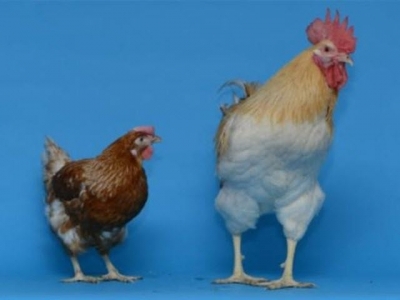Gene expression tied to dimorphism in chickens

New study explores sex differences in expression of genes involved in control of food intake and bodyweight in chickens. Photo: The Roslin Institute
Sexual dimorphism a condition where the two sexes have different characteristics beyond the differences in their sexual organs can be found everywhere. Differences in plumage, pelage or ornamentation are observed across the animal kingdom, with many species also displaying difference in body size and weight, according to an announcement from The Roslin Institute in the U.K.
This is also a characteristic in chickens, as male chickens tend to be bigger and heavier than females. How do genetics result in these differences?
The institute explained that appetite and food intake are largely controlled by a region of the brain known as the hypothalamus, where specialized cells called neurons send messages from the brain to the body. For instance, depending on the proteins that are expressed, neurons will tell the body whether the individual is hungry or not. Therefore, the balance of these proteins is crucial to the control of feeding behavior, growth and bodyweight.
A study led by Dr. Sarah Caughey from The Roslin Institute looked at what happens in the brain of male and female chickens when they are allowed to eat as much as they want compared to when food intake is restricted.
The team observed that when the amount of food birds received was restricted, there was an increase in the expression of a protein that drives feeding behavior, called the agouti-related protein (AGRP). They also noted that expression of proteins that stimulate appetite was higher in males than females. Inversely, they observed no sex differences in the gene expression of anorectic genes. These results could be a useful starting point for investigating further if AGRP is an indicator of growth potential, the announcement said.
"Understanding the growth potential of a bird could have important applications in the meat industry, especially for meat production, with chicken meat and eggs providing at least a third of the world’s animal protein. This is also of great interest in humans, particularly in the context of over-consumption and obesity," Caughey said.
The study, which was funded by the U.K.'s Biotechnology & Biological Sciences Research Council and the Rural & Environmental Science & Analytical Services Division of the Scottish Government, was published in the journal Biology of Sex Differences.
It was conducted by researchers at The Roslin Institute, Bioinformatics & Statistics Scotland, Scotland’s Rural College and the School of Natural & Environmental Sciences of the University of Newcastle in the U.K
Related news
 Beware of cold temperatures affecting feed intake and layer performance
Beware of cold temperatures affecting feed intake and layer performance ABN nutrition experts suggest feed programs may need to be revised. Beware of cold temperatures affecting feed intake and layer performance
 Advances in nutrition
Advances in nutrition Egg production and quality were evaluated over 36 weeks of production from 17 weeks of age onwards in Hy-Line brown-feathered hens.
 Latest advances in poultry health
Latest advances in poultry health The application of molecular biology to determine the genomic structure, classification and pathogenesis of disease-causing agents in poultry was a consistent